check oil INFINITI QX50 2021 User Guide
[x] Cancel search | Manufacturer: INFINITI, Model Year: 2021, Model line: QX50, Model: INFINITI QX50 2021Pages: 542, PDF Size: 3.51 MB
Page 436 of 542
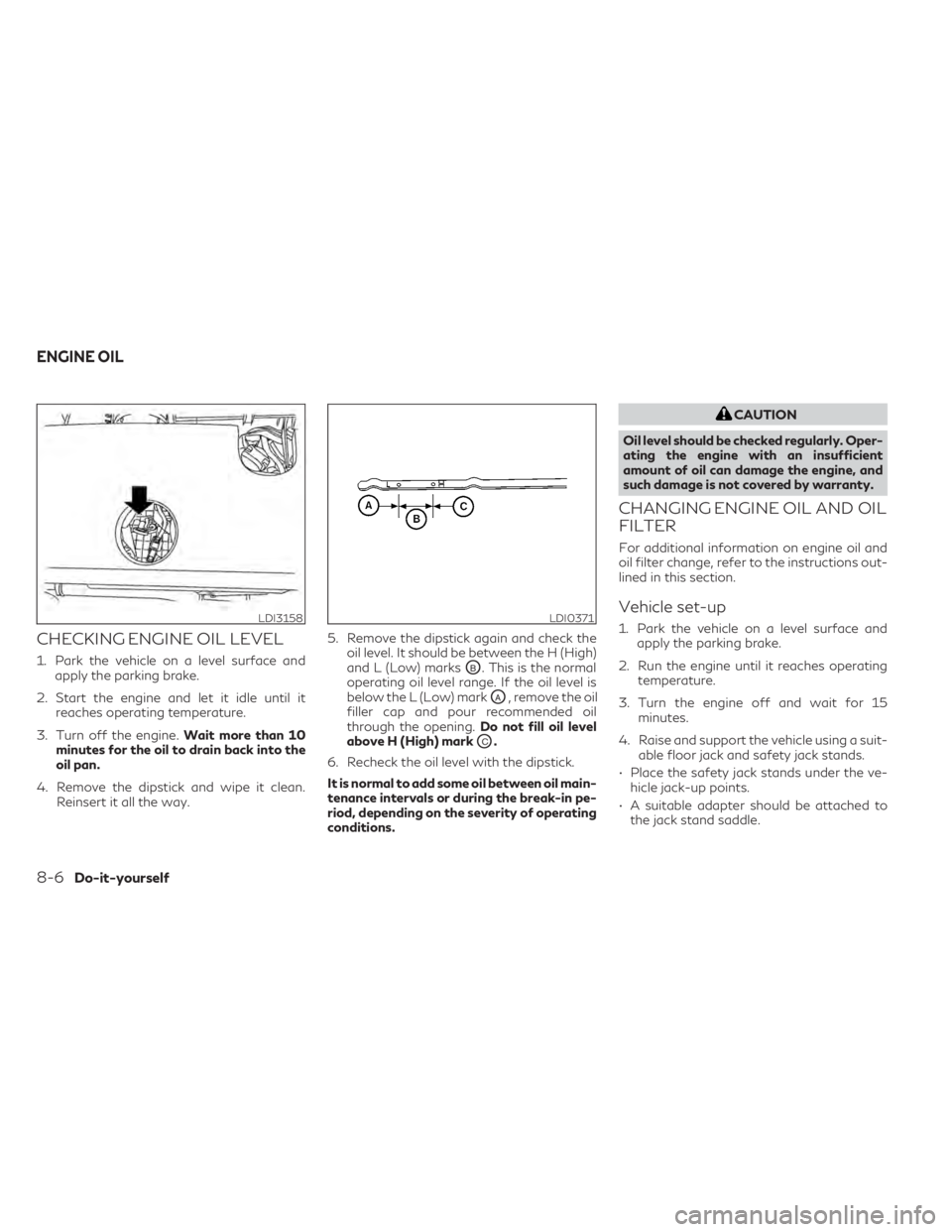
CHECKING ENGINE OIL LEVEL
1. Park the vehicle on a level surface andapply the parking brake.
2. Start the engine and let it idle until it reaches operating temperature.
3. Turn off the engine. Wait more than 10
minutes for the oil to drain back into the
oil pan.
4. Remove the dipstick and wipe it clean. Reinsert it all the way. 5. Remove the dipstick again and check the
oil level. It should be between the H (High)
and L (Low) marksOB. This is the normal
operating oil level range. If the oil level is
below the L (Low) mark
OA, remove the oil
filler cap and pour recommended oil
through the opening. Do not fill oil level
above H (High) mark
OC.
6. Recheck the oil level with the dipstick.
It is normal to add some oil between oil main-
tenance intervals or during the break-in pe-
riod, depending on the severity of operating
conditions.
CAUTION
Oil level should be checked regularly. Oper-
ating the engine with an insufficient
amount of oil can damage the engine, and
such damage is not covered by warranty.
CHANGING ENGINE OIL AND OIL
FILTER
For additional information on engine oil and
oil filter change, refer to the instructions out-
lined in this section.
Vehicle set-up
1. Park the vehicle on a level surface and apply the parking brake.
2. Run the engine until it reaches operating temperature.
3. Turn the engine off and wait for 15 minutes.
4. Raise and support the vehicle using a suit- able floor jack and safety jack stands.
• Place the safety jack stands under the ve- hicle jack-up points.
• A suitable adapter should be attached to the jack stand saddle.LDI3158LDI0371
ENGINE OIL
8-6Do-it-yourself
Page 439 of 542

CAUTION
Be careful not to burn yourself, as the en-
gine oil is hot.
WARNING
• Prolonged and repeated contact with
used engine oil may cause skin cancer.
• Try to avoid direct skin contact with
used oil. If skin contact is made, wash
thoroughly with soap or hand cleaner as
soon as possible.
• Keep used engine oil out of reach of
children.
4. Loosen the oil filter with an oil filter wrench by turning it counterclockwise.
Remove the oil filter by turning it by hand.
5. Wipe the engine oil filter mounting sur- face with a clean rag.
CAUTION
Be sure to remove any old gasket material
remaining on the sealing surface of the en-
gine. Failure to do so could lead to an oil
leak and engine damage. •
The dipstick must be inserted in place to
prevent oil spillage from the dipstick hole
when filling the engine with oil.
6. Coat the gasket on the new filter with clean engine oil.
7. Screw in the oil filter clockwise until a slight resistance is felt, then tighten addi-
tionally more than 2/3 turn.
Oil filter tightening torque: 14.7 to 20.6 N·m (11 to 15 ft-lb)
8. Clean and re-install the drain plug with a new washer. Securely tighten the drain
plug with a wrench. Do not use excessive
force.
Drain plug tightening torque: 29.4 to 39.2 N·m (22 to 29 ft-lb)
9. Refill the engine with the recommended oil through the oil filler opening, and install
the oil filler cap securely.
For additional information about drain and
refill capacity, see “Recommended fluids/
lubricants and capacities” (P. 10-2). The drain
and refill capacity depends on the oil tem-
perature and drain time. Use these specifica-
tions for reference only. Always use the dip-
stick to determine the proper amount of oil in
the engine. 10. Start the engine and check for leakage
around the drain plug and the oil filter.
Correct as required. Turn the engine off
and wait more than 15 minutes. Check
the oil level with the dipstick. Add engine
oil if necessary.
After the operation
1. Reinstall engine protectors in reverse or-der of removal.
2. Lower the vehicle carefully to the ground.
3. Reset the oil control system. For addi- tional information, see “Vehicle informa-
tion display” (P. 2-19)
• Dispose of waste oil and filter properly.
• Check your local regulations.
Do-it-yourself8-9
Page 474 of 542
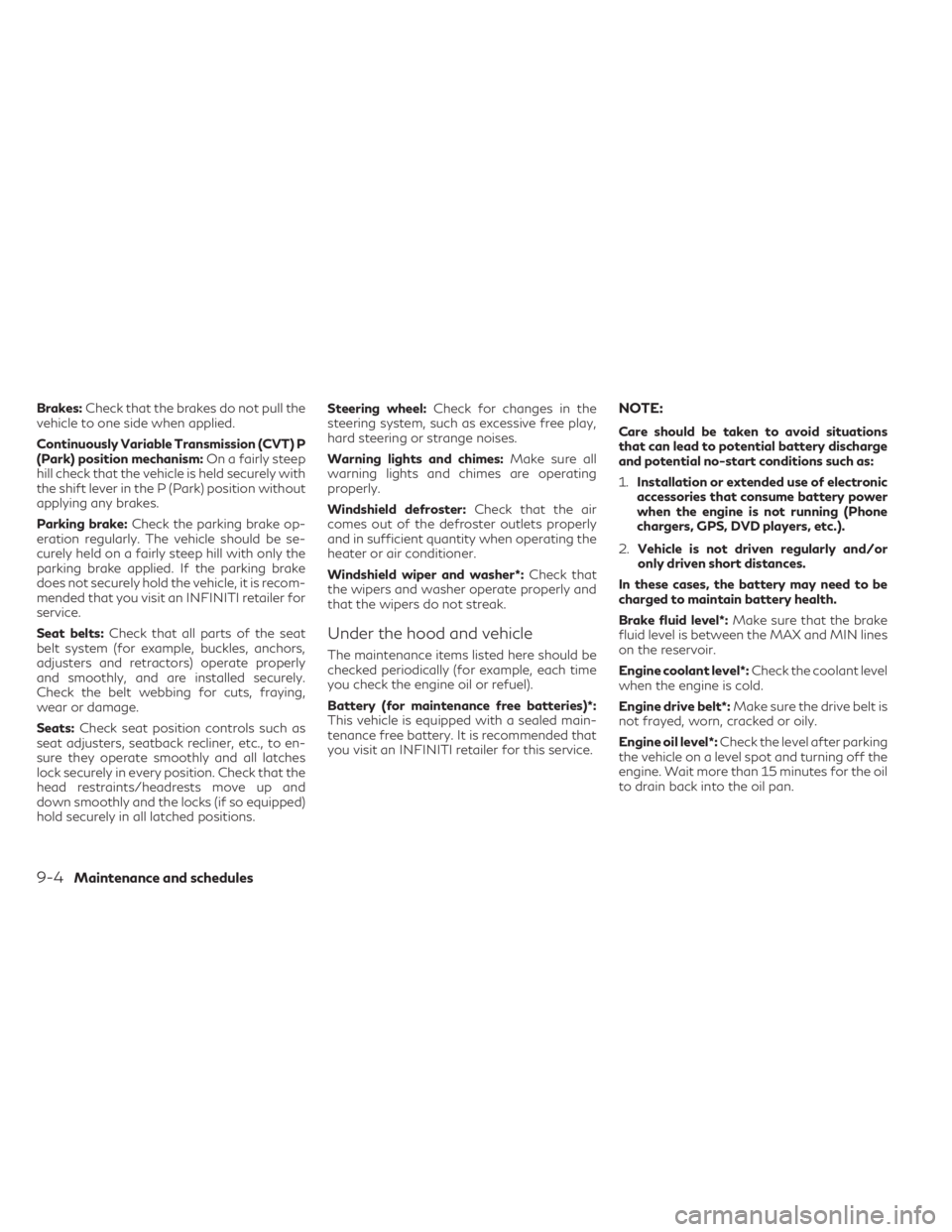
Brakes:Check that the brakes do not pull the
vehicle to one side when applied.
Continuously Variable Transmission (CVT) P
(Park) position mechanism: On a fairly steep
hill check that the vehicle is held securely with
the shift lever in the P (Park) position without
applying any brakes.
Parking brake: Check the parking brake op-
eration regularly. The vehicle should be se-
curely held on a fairly steep hill with only the
parking brake applied. If the parking brake
does not securely hold the vehicle, it is recom-
mended that you visit an INFINITI retailer for
service.
Seat belts: Check that all parts of the seat
belt system (for example, buckles, anchors,
adjusters and retractors) operate properly
and smoothly, and are installed securely.
Check the belt webbing for cuts, fraying,
wear or damage.
Seats: Check seat position controls such as
seat adjusters, seatback recliner, etc., to en-
sure they operate smoothly and all latches
lock securely in every position. Check that the
head restraints/headrests move up and
down smoothly and the locks (if so equipped)
hold securely in all latched positions. Steering wheel:
Check for changes in the
steering system, such as excessive free play,
hard steering or strange noises.
Warning lights and chimes: Make sure all
warning lights and chimes are operating
properly.
Windshield defroster: Check that the air
comes out of the defroster outlets properly
and in sufficient quantity when operating the
heater or air conditioner.
Windshield wiper and washer*: Check that
the wipers and washer operate properly and
that the wipers do not streak.
Under the hood and vehicle
The maintenance items listed here should be
checked periodically (for example, each time
you check the engine oil or refuel).
Battery (for maintenance free batteries)*:
This vehicle is equipped with a sealed main-
tenance free battery. It is recommended that
you visit an INFINITI retailer for this service.
NOTE:
Care should be taken to avoid situations
that can lead to potential battery discharge
and potential no-start conditions such as:
1. Installation or extended use of electronic
accessories that consume battery power
when the engine is not running (Phone
chargers, GPS, DVD players, etc.).
2. Vehicle is not driven regularly and/or
only driven short distances.
In these cases, the battery may need to be
charged to maintain battery health.
Brake fluid level*: Make sure that the brake
fluid level is between the MAX and MIN lines
on the reservoir.
Engine coolant level*: Check the coolant level
when the engine is cold.
Engine drive belt*: Make sure the drive belt is
not frayed, worn, cracked or oily.
Engine oil level*: Check the level after parking
the vehicle on a level spot and turning off the
engine. Wait more than 15 minutes for the oil
to drain back into the oil pan.
9-4Maintenance and schedules
Page 475 of 542

Exhaust system:Make sure there are no
loose supports, cracks or holes. If the sound
of the exhaust seems unusual or there is a
smell of exhaust fumes, immediately have the
exhaust system inspected. It is recommended
that you visit an INFINITI retailer for this
service. For additional information, see “Ex-
haust gas (carbon monoxide)” (P. 5-4).
Fluid leaks: Check under the vehicle for fuel,
oil, water or other fluid leaks after the vehicle
has been parked for a while. Water dripping
from the air conditioner after use is normal. If
you should notice any leaks or if fuel fumes
are evident, check for the cause and have it
corrected immediately.
Radiator and hoses: Check the front of the
radiator and clean off any dirt, insects, leaves,
etc., that may have accumulated. Make sure
the hoses have no cracks, deformation, rot or
loose connections. Underbody:
The underbody is frequently ex-
posed to corrosive substances such as those
used on icy roads or to control dust. It is very
important to remove these substances, oth-
erwise rust may form on the floor pan, frame,
fuel lines and around the exhaust system. At
the end of winter, the underbody should be
thoroughly flushed with plain water, being
careful to clean those areas where mud and
dirt may accumulate. For additional informa-
tion, see “Cleaning exterior” (P. 7-2).
Windshield-washer fluid*: Check that there
is adequate fluid in the reservoir. The following descriptions are provided to
give you a better understanding of the sched-
uled maintenance items that should be regu-
larly checked or replaced. The maintenance
schedule indicates at which mileage/time in-
tervals each item requires service.
In addition to scheduled maintenance, your
vehicle requires that some items be checked
during normal day-to-day operation. For ad-
ditional information, see “General mainte-
nance” (P. 9-2).
Items marked with
“*”are recommended by
INFINITI for reliable vehicle operation. You
are not required to perform maintenance on
these items in order to maintain the warran-
ties which come with your INFINITI. Other
maintenance items and intervals are required.
When applicable, additional information can
be found in the “Do-it-yourself” section of
this manual.
EXPLANATION OF SCHEDULED
MAINTENANCE ITEMS
Maintenance and schedules9-5
Page 476 of 542
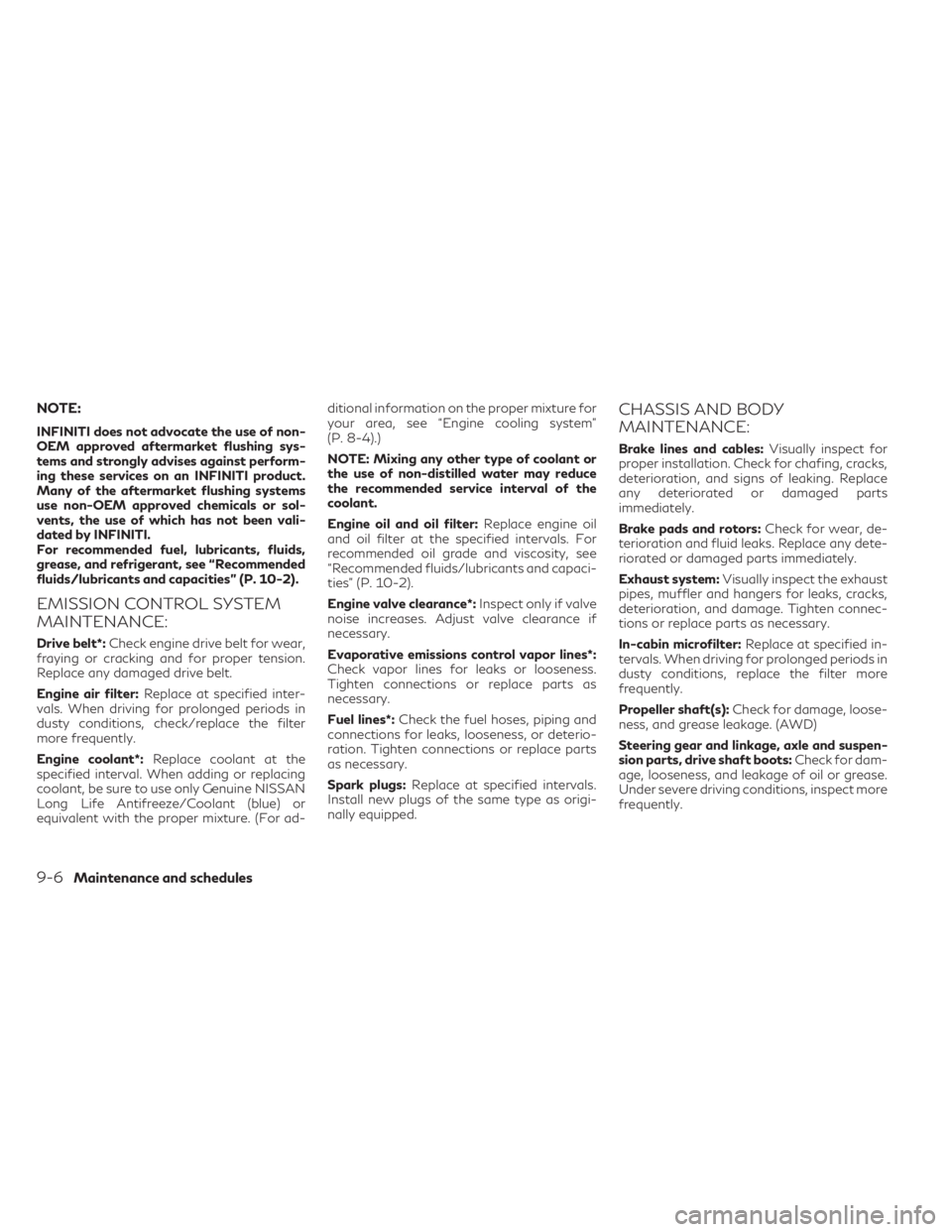
NOTE:
INFINITI does not advocate the use of non-
OEM approved aftermarket flushing sys-
tems and strongly advises against perform-
ing these services on an INFINITI product.
Many of the aftermarket flushing systems
use non-OEM approved chemicals or sol-
vents, the use of which has not been vali-
dated by INFINITI.
For recommended fuel, lubricants, fluids,
grease, and refrigerant, see “Recommended
fluids/lubricants and capacities” (P. 10-2).
EMISSION CONTROL SYSTEM
MAINTENANCE:
Drive belt*:Check engine drive belt for wear,
fraying or cracking and for proper tension.
Replace any damaged drive belt.
Engine air filter: Replace at specified inter-
vals. When driving for prolonged periods in
dusty conditions, check/replace the filter
more frequently.
Engine coolant*: Replace coolant at the
specified interval. When adding or replacing
coolant, be sure to use only Genuine NISSAN
Long Life Antifreeze/Coolant (blue) or
equivalent with the proper mixture. (For ad- ditional information on the proper mixture for
your area, see “Engine cooling system”
(P. 8-4).)
NOTE: Mixing any other type of coolant or
the use of non-distilled water may reduce
the recommended service interval of the
coolant.
Engine oil and oil filter:
Replace engine oil
and oil filter at the specified intervals. For
recommended oil grade and viscosity, see
“Recommended fluids/lubricants and capaci-
ties” (P. 10-2).
Engine valve clearance*: Inspect only if valve
noise increases. Adjust valve clearance if
necessary.
Evaporative emissions control vapor lines*:
Check vapor lines for leaks or looseness.
Tighten connections or replace parts as
necessary.
Fuel lines*: Check the fuel hoses, piping and
connections for leaks, looseness, or deterio-
ration. Tighten connections or replace parts
as necessary.
Spark plugs: Replace at specified intervals.
Install new plugs of the same type as origi-
nally equipped.
CHASSIS AND BODY
MAINTENANCE:
Brake lines and cables: Visually inspect for
proper installation. Check for chafing, cracks,
deterioration, and signs of leaking. Replace
any deteriorated or damaged parts
immediately.
Brake pads and rotors: Check for wear, de-
terioration and fluid leaks. Replace any dete-
riorated or damaged parts immediately.
Exhaust system: Visually inspect the exhaust
pipes, muffler and hangers for leaks, cracks,
deterioration, and damage. Tighten connec-
tions or replace parts as necessary.
In-cabin microfilter: Replace at specified in-
tervals. When driving for prolonged periods in
dusty conditions, replace the filter more
frequently.
Propeller shaft(s): Check for damage, loose-
ness, and grease leakage. (AWD)
Steering gear and linkage, axle and suspen-
sion parts, drive shaft boots: Check for dam-
age, looseness, and leakage of oil or grease.
Under severe driving conditions, inspect more
frequently.
9-6Maintenance and schedules
Page 477 of 542
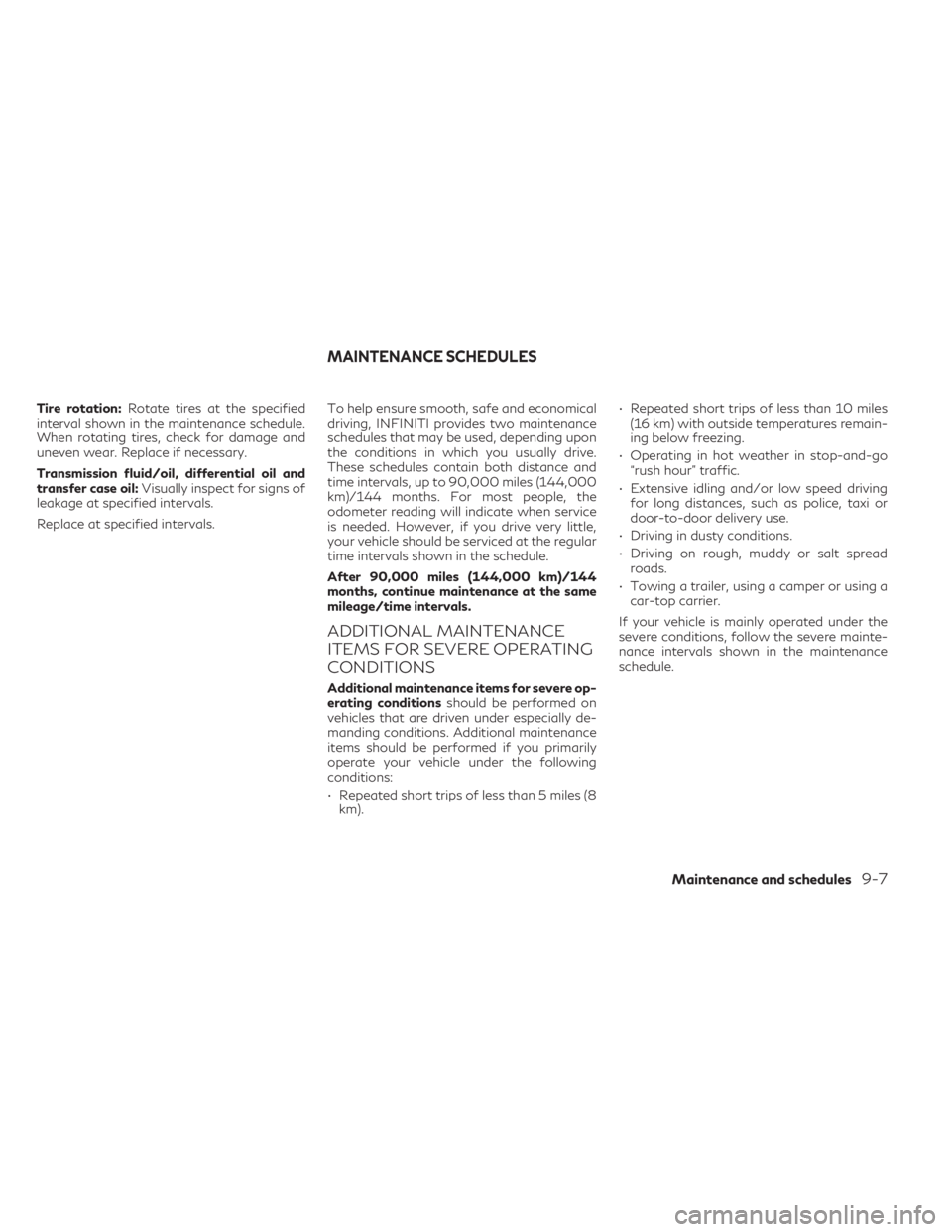
Tire rotation:Rotate tires at the specified
interval shown in the maintenance schedule.
When rotating tires, check for damage and
uneven wear. Replace if necessary.
Transmission fluid/oil, differential oil and
transfer case oil: Visually inspect for signs of
leakage at specified intervals.
Replace at specified intervals. To help ensure smooth, safe and economical
driving, INFINITI provides two maintenance
schedules that may be used, depending upon
the conditions in which you usually drive.
These schedules contain both distance and
time intervals, up to 90,000 miles (144,000
km)/144 months. For most people, the
odometer reading will indicate when service
is needed. However, if you drive very little,
your vehicle should be serviced at the regular
time intervals shown in the schedule.
After 90,000 miles (144,000 km)/144
months, continue maintenance at the same
mileage/time intervals.
ADDITIONAL MAINTENANCE
ITEMS FOR SEVERE OPERATING
CONDITIONS
Additional maintenance items for severe op-
erating conditions
should be performed on
vehicles that are driven under especially de-
manding conditions. Additional maintenance
items should be performed if you primarily
operate your vehicle under the following
conditions:
• Repeated short trips of less than 5 miles (8 km). • Repeated short trips of less than 10 miles
(16 km) with outside temperatures remain-
ing below freezing.
• Operating in hot weather in stop-and-go “rush hour” traffic.
• Extensive idling and/or low speed driving for long distances, such as police, taxi or
door-to-door delivery use.
• Driving in dusty conditions.
• Driving on rough, muddy or salt spread roads.
• Towing a trailer, using a camper or using a car-top carrier.
If your vehicle is mainly operated under the
severe conditions, follow the severe mainte-
nance intervals shown in the maintenance
schedule.
MAINTENANCE SCHEDULES
Maintenance and schedules9-7
Page 524 of 542
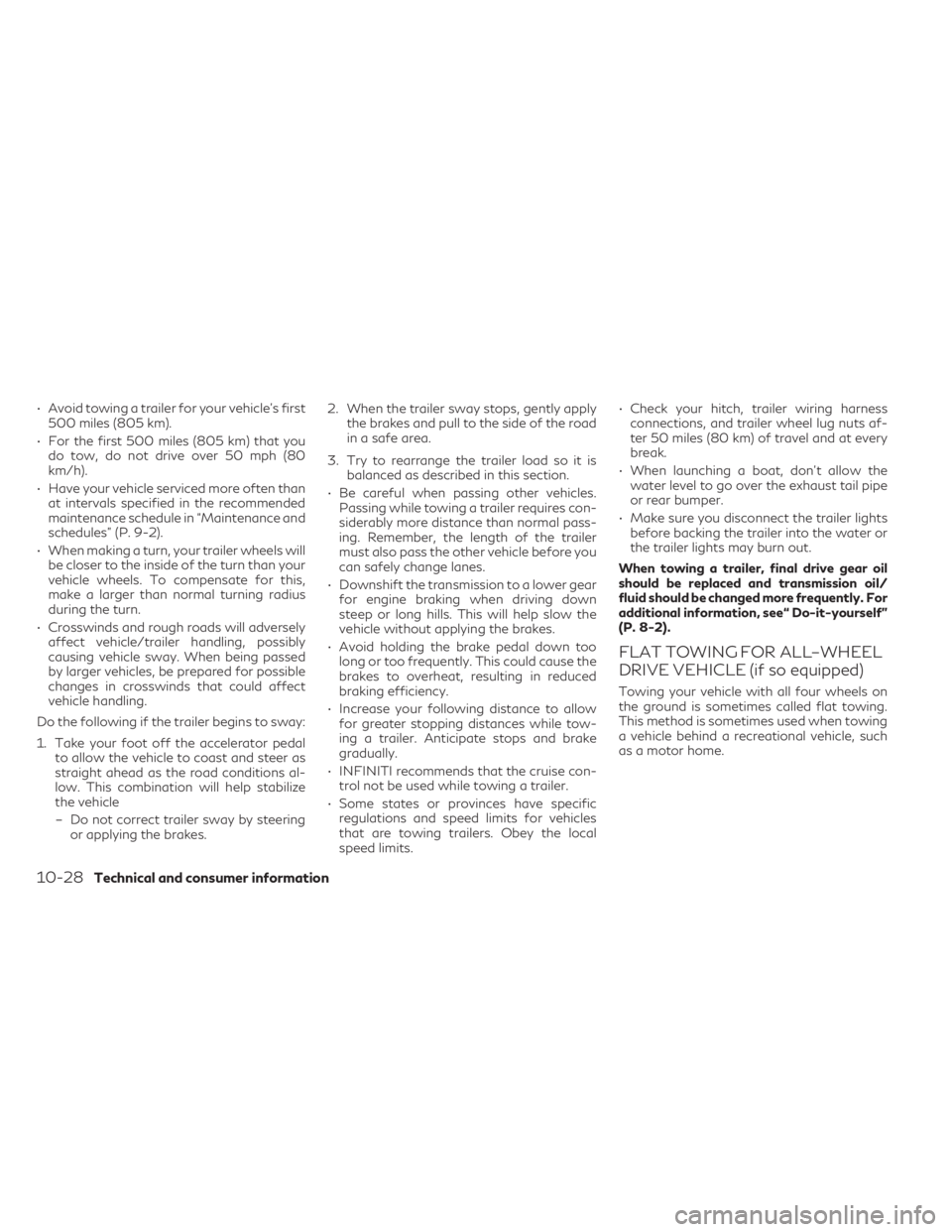
• Avoid towing a trailer for your vehicle's first500 miles (805 km).
• For the first 500 miles (805 km) that you do tow, do not drive over 50 mph (80
km/h).
• Have your vehicle serviced more often than at intervals specified in the recommended
maintenance schedule in “Maintenance and
schedules” (P. 9-2).
• When making a turn, your trailer wheels will be closer to the inside of the turn than your
vehicle wheels. To compensate for this,
make a larger than normal turning radius
during the turn.
• Crosswinds and rough roads will adversely affect vehicle/trailer handling, possibly
causing vehicle sway. When being passed
by larger vehicles, be prepared for possible
changes in crosswinds that could affect
vehicle handling.
Do the following if the trailer begins to sway:
1. Take your foot off the accelerator pedal to allow the vehicle to coast and steer as
straight ahead as the road conditions al-
low. This combination will help stabilize
the vehicle
– Do not correct trailer sway by steering or applying the brakes. 2. When the trailer sway stops, gently apply
the brakes and pull to the side of the road
in a safe area.
3. Try to rearrange the trailer load so it is balanced as described in this section.
• Be careful when passing other vehicles. Passing while towing a trailer requires con-
siderably more distance than normal pass-
ing. Remember, the length of the trailer
must also pass the other vehicle before you
can safely change lanes.
• Downshift the transmission to a lower gear for engine braking when driving down
steep or long hills. This will help slow the
vehicle without applying the brakes.
• Avoid holding the brake pedal down too long or too frequently. This could cause the
brakes to overheat, resulting in reduced
braking efficiency.
• Increase your following distance to allow for greater stopping distances while tow-
ing a trailer. Anticipate stops and brake
gradually.
• INFINITI recommends that the cruise con- trol not be used while towing a trailer.
• Some states or provinces have specific regulations and speed limits for vehicles
that are towing trailers. Obey the local
speed limits. • Check your hitch, trailer wiring harness
connections, and trailer wheel lug nuts af-
ter 50 miles (80 km) of travel and at every
break.
• When launching a boat, don't allow the water level to go over the exhaust tail pipe
or rear bumper.
• Make sure you disconnect the trailer lights before backing the trailer into the water or
the trailer lights may burn out.
When towing a trailer, final drive gear oil
should be replaced and transmission oil/
fluid should be changed more frequently. For
additional information, see“ Do-it-yourself”
(P. 8-2).
FLAT TOWING FOR ALL–WHEEL
DRIVE VEHICLE (if so equipped)
Towing your vehicle with all four wheels on
the ground is sometimes called flat towing.
This method is sometimes used when towing
a vehicle behind a recreational vehicle, such
as a motor home.
10-28Technical and consumer information
Page 531 of 542
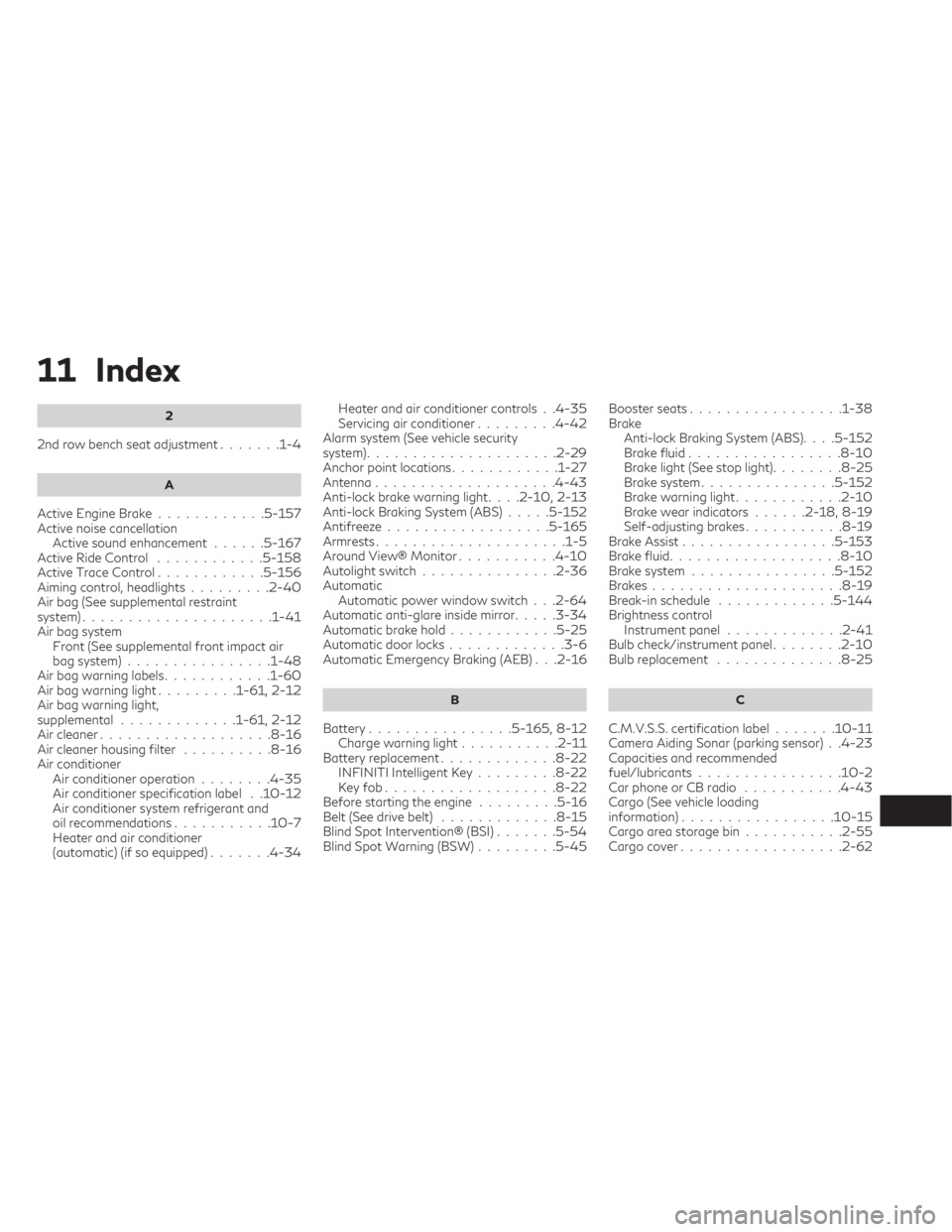
11 Index
2
2nd row bench seat adjustment.......1-4
A
Active Engine Brake............5-157Active noise cancellation
Active sound enhancement......5-167Active Ride Control........... .5-158Active Trace Control............5-156Aiming control, headlights.........2-40Air bag (See supplemental restraint
system).................... .1-41Air bag system
Front (See supplemental front impact air
bag system)
............... .1-48Air bag warning labels............1-60Air bag warning light.........1-61, 2-12Air bag warning light,
supplemental............ .1-61, 2-12Air cleaner.................. .8-16Air cleaner housing filter..........8-16Air conditioner
Air conditioner operation........4-35Air conditioner specification label. .10-12Air conditioner system refrigerant and
oil recommendations.......... .10-7Heater and air conditioner
(automatic) (if so equipped).......4-34
Heater and air conditioner controls. .4-35Servicing air conditioner.........4-42Alarm system (See vehicle security
system).................... .2-29Anchor point locations............1-27Antenna................... .4-43Anti-lock brake warning light. . . .2-10, 2-13Anti-lock Braking System (ABS).....5-152Antifreeze..................5-165Armrests.................... .1-5Around View® Monitor...........4-10Autolight switch.............. .2-36Automatic
Automatic power window switch. . .2-64Automatic anti-glare inside mirror.....3-34Automatic brake hold........... .5-25Automatic door locks............ .3-6Automatic Emergency Braking (AEB). . .2-16
B
Battery............... .5-165, 8-12Charge warning light...........2-11Battery replacement............ .8-22INFINITI Intelligent Key.........8-22Key fob.................. .8-22Before starting the engine.........5-16Belt (See drive belt).............8-15Blind Spot Intervention® (BSI).......5-54Blind Spot Warning (BSW).........5-45
Booster seats................ .1-38Brake
Anti-lock Braking System (ABS). . . .5-152Brake fluid................ .8-10Brake light (See stop light)........8-25Brake system...............5-152Brake warning light............2-10Brake wear indicators......2-18, 8-19Self-adjusting brakes...........8-19Brake Assist................ .5-153Brake fluid.................. .8-10Brake system................5-152Brakes.................... .8-19Break-in schedule.............5-144Brightness control
Instrument panel............ .2-41Bulb check/instrument panel........2-10Bulb replacement............. .8-25
C
C.M.V.S.S. certification label.......10-11Camera Aiding Sonar (parking sensor). .4-23Capacities and recommended
fuel/lubricants............... .10-2Car phone or CB radio...........4-43Cargo (See vehicle loading
information)................ .10-15Cargo area storage bin...........2-55Cargo cover................. .2-62
Page 532 of 542
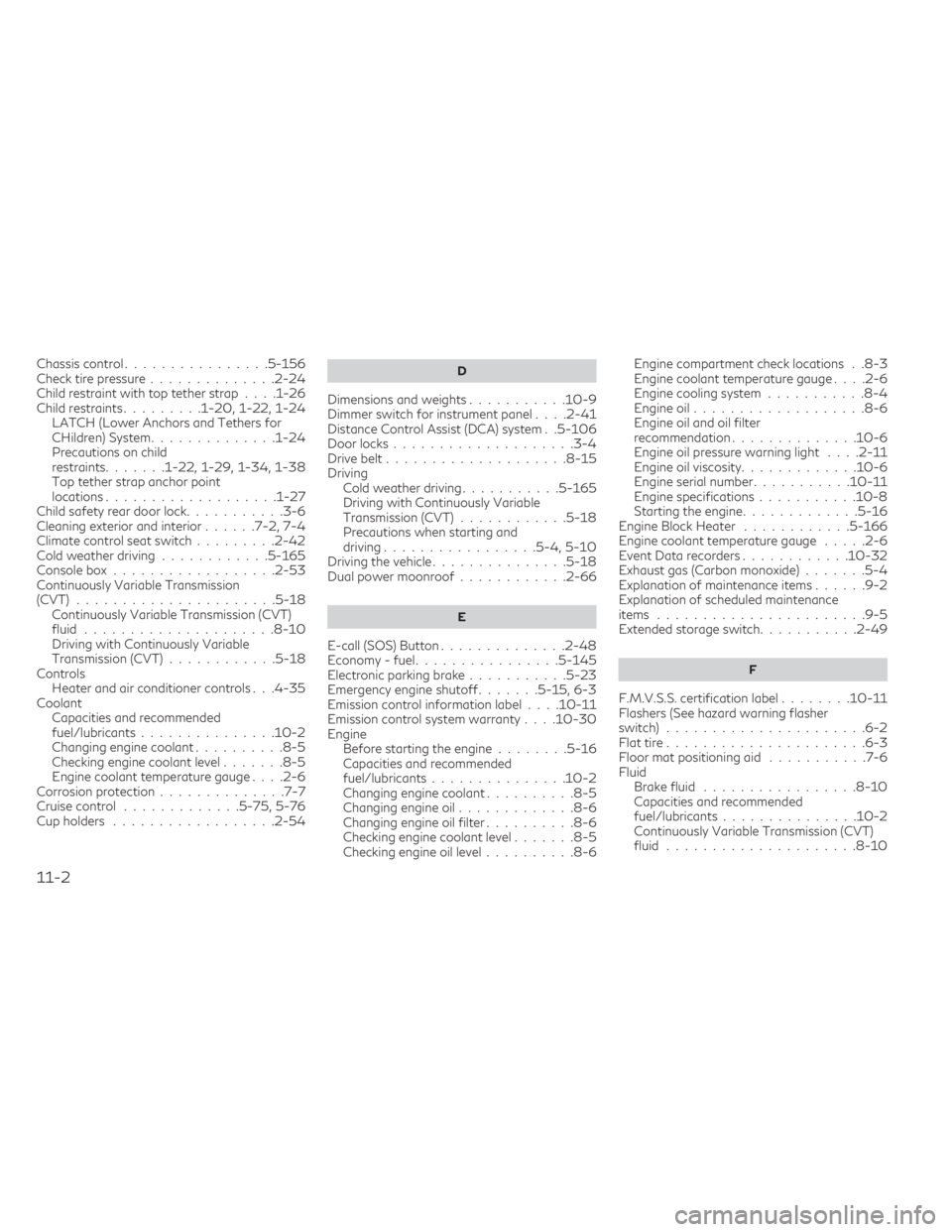
Chassis control................5-156Check tire pressure..............2-24Child restraint with top tether strap. . . .1-26Child restraints.........1-20, 1-22, 1-24LATCH (Lower Anchors and Tethers for
CHildren) System..............1-24Precautions on child
restraints.......1-22, 1-29, 1-34, 1-38Top tether strap anchor point
locations.................. .1-27Child safety rear door lock...........3-6Cleaning exterior and interior......7-2, 7-4Climate control seat switch.........2-42Cold weather driving........... .5-165Console box................. .2-53Continuously Variable Transmission
(CVT)..................... .5-18Continuously Variable Transmission (CVT)
fluid.....................8-10Driving with Continuously Variable
Transmission (CVT)............5-18Controls
Heater and air conditioner controls. . .4-35CoolantCapacities and recommended
fuel/lubricants
.............. .10-2Changing engine coolant..........8-5Checking engine coolant level.......8-5Engine coolant temperature gauge. . . .2-6Corrosion protection..............7-7Cruise control.............5-75, 5-76Cup holders................. .2-54
D
Dimensions and weights...........10-9Dimmer switch for instrument panel. . . .2-41Distance Control Assist (DCA) system. .5-106Door locks................... .3-4Drive belt....................8-15Driving
Cold weather driving.......... .5-165Driving with Continuously Variable
Transmission (CVT)........... .5-18Precautions when starting and
driving................ .5-4, 5-10Driving the vehicle...............5-18Dual power moonroof............2-66
E
E-call (SOS) Button............. .2-48Economy - fuel............... .5-145Electronic parking brake...........5-23Emergency engine shutoff.......5-15, 6-3Emission control information label. . . .10-11Emission control system warranty. . . .10-30Engine
Before starting the engine........5-16Capacities and recommended
fuel/lubricants.............. .10-2Changing engine coolant..........8-5Changing engine oil.............8-6Changing engine oil filter..........8-6Checking engine coolant level.......8-5Checking engine oil level..........8-6
Engine compartment check locations. .8-3Engine coolant temperature gauge. . . .2-6Engine cooling system...........8-4Engine oil.................. .8-6Engine oil and oil filter
recommendation..............10-6Engine oil pressure warning light. . . .2-11Engine oil viscosity.............10-6Engine serial number...........10-11Engine specifications...........10-8Starting the engine............ .5-16Engine Block Heater............5-166Engine coolant temperature gauge. . . . .2-6Event Data recorders............10-32Exhaust gas (Carbon monoxide).......5-4Explanation of maintenance items......9-2Explanation of scheduled maintenance
items...................... .9-5Extended storage switch...........2-49
F
F.M.V.S.S. certification label........10-11Flashers (See hazard warning flasher
switch)..................... .6-2Flat tire......................6-3Floor mat positioning aid...........7-6Fluid
Brake fluid................ .8-10Capacities and recommended
fuel/lubricants...............10-2Continuously Variable Transmission (CVT)
fluid.................... .8-10
11-2
Page 535 of 542
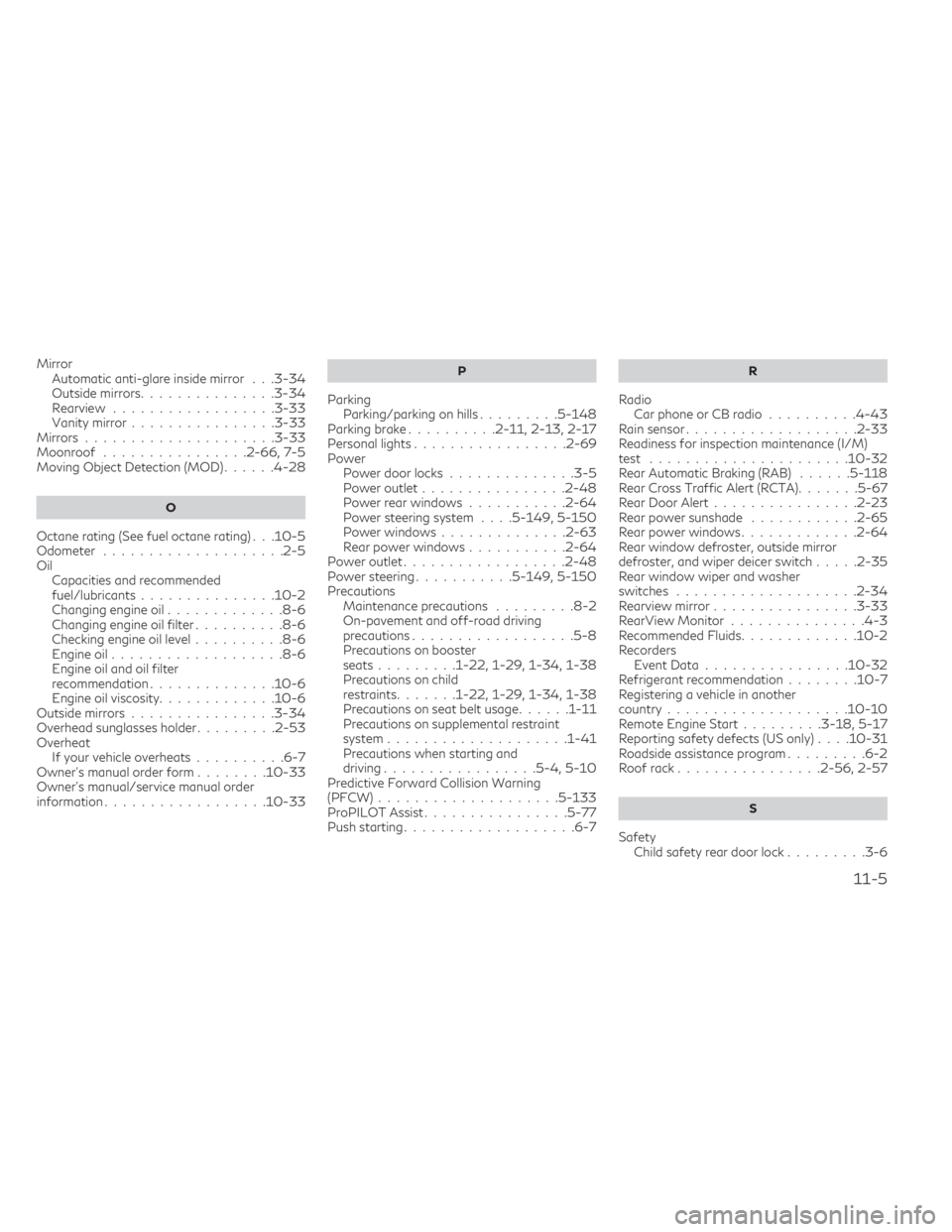
MirrorAutomatic anti-glare inside mirror. . .3-34Outside mirrors.............. .3-34Rearview................. .3-33Vanity mirror................3-33Mirrors.................... .3-33Moonroof................2-66, 7-5Moving Object Detection (MOD)......4-28
O
Octane rating (See fuel octane rating). . .10-5Odometer................... .2-5Oil
Capacities and recommended
fuel/lubricants
.............. .10-2Changing engine oil.............8-6Changing engine oil filter..........8-6Checking engine oil level..........8-6Engine oil.................. .8-6Engine oil and oil filter
recommendation..............10-6Engine oil viscosity.............10-6Outside mirrors............... .3-34Overhead sunglasses holder.........2-53Overheat
If your vehicle overheats..........6-7Owner's manual order form........10-33Owner's manual/service manual order
information................. .10-33
P
Parking
Parking/parking on hills.........5-148Parking brake..........2-11, 2-13, 2-17Personal lights................ .2-69Power
Power door locks............. .3-5Power outlet............... .2-48Power rear windows...........2-64Power steering system. . . .5-149, 5-150Power windows............. .2-63Rear power windows...........2-64Power outlet................. .2-48Power steering...........5-149, 5-150Precautions
Maintenance precautions.........8-2On-pavement and off-road driving
precautions................. .5-8Precautions on booster
seats.........1-22, 1-29, 1-34, 1-38Precautions on child
restraints.......1-22, 1-29, 1-34, 1-38Precautions on seat belt usage......1-11Precautions on supplemental restraint
system................... .1-41Precautions when starting and
driving.................5-4, 5-10Predictive Forward Collision Warning
(PFCW)................... .5-133ProPILOT Assist................5-77Push starting.................. .6-7
R
Radio
Car phone or CB radio..........4-43Rain sensor.................. .2-33Readiness for inspection maintenance (I/M)
test..................... .10-32Rear Automatic Braking (RAB)......5-118Rear Cross Traffic Alert (RCTA).......5-67Rear Door Alert................2-23Rear power sunshade............2-65Rear power windows............ .2-64Rear window defroster, outside mirror
defroster, and wiper deicer switch.....2-35Rear window wiper and washer
switches................... .2-34Rearview mirror................3-33RearView Monitor...............4-3Recommended Fluids.............10-2Recorders
Event Data............... .10-32Refrigerant recommendation........10-7Registering a vehicle in another
country................... .10-10Remote Engine Start.........3-18, 5-17Reporting safety defects (US only). . . .10-31Roadside assistance program.........6-2Roof rack................2-56, 2-57
S
Safety
Child safety rear door lock.........3-6
11-5